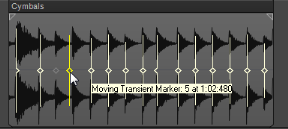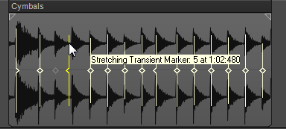Transient markers show where the transients of a clip are (areas where the level increases suddenly), and are used to edit the timing of audio clips.AudioSnap finds transients automatically, but the transient markers don’t always appear exactly where you might want them for the kind of editing you want to do.Most AudioSnap commands edit transient markers automatically as a result of an editing operation, but sometimes you achieve the best results by editing the markers manually.You can edit the markers by moving them to new locations, adding markers, filtering out markers, deleting markers, and promoting markers (protecting them from being filtered).Figure 200. Transient markers

in the AudioSnap palette to open the AudioSnap Options dialog box, then specify the desired Pool Transient Window value.
When editing multi-track instruments, you may want to simultaneously adjust a range of transients across multiple tracks. In order to do so, you need to select the tracks and time region you want to edit.








(or press the N key) if the place you need the marker is not on a convenient snap location.
The marker appears in the selected clip(s) and displays a hollow square to show that it is a manually created marker:




Tip - Searching Documentation
Tip: To search for a specific topic, type your search query in the Search Cakewalk.com field at the top right of this page.
When the search results appear, click which product's documentation you would like to search to filter the search results further.
Note - Using Offline Help
Note: If you prefer to always use offline Help, go to Edit > Preferences > File > Advanced in your Cakewalk software and select Always Use Offline Help.
If you are not connected to the internet, your Cakewalk software will default to showing offline help until an internet connection becomes available.






